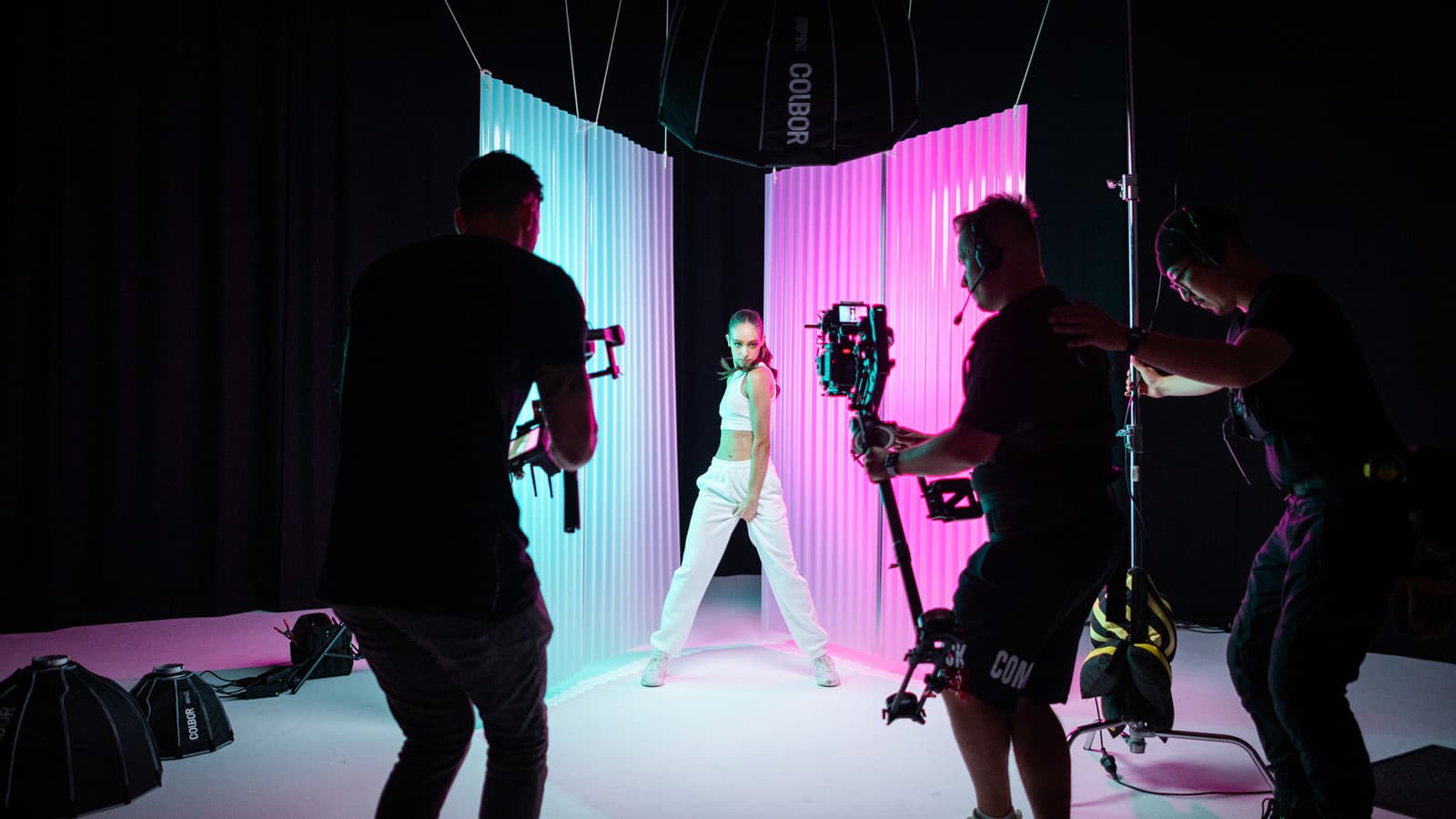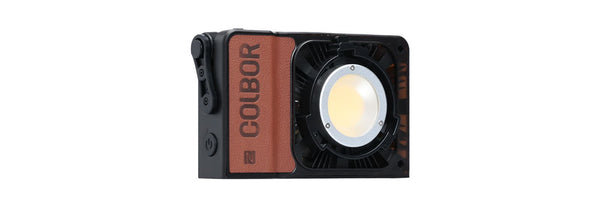Light for studio video is a key element in studio production. It's the secret ingredient that can transform a good video into a captivating masterpiece. Whether you're filming interviews, product reviews, or creative narratives, the way you illuminate your subjects and scenes plays a pivotal role in setting the mood, enhancing visual clarity, and capturing attention. Keep reading to delve deeper into:
- Why is lighting crucial in studio video?
- What types of lights are commonly used?
- What are the top picks at COLBOR?
- How to use light effectively to achieve professional results in your studio productions?
Whether you're a seasoned videographer or a newcomer looking to improve your skills, mastering the art of lighting is key to creating compelling and visually stunning videos.

Why is studio light important for video creation?
Video content is based on visuals, so it's no surprise that selecting the ideal lighting for studio video recording is critical for content creators. It will make or break the video’ overall performance.
The proper lighting for studio video will:
Improve video mood and tone: Video lighting significantly influences the overall atmosphere of your video. Lighting plays a pivotal role in crafting captivating visuals that attract viewers and maintain their interest. It's essential for storytelling, enhancing your narrative's impact.
Boost viewer engagement: Proper lighting in studio video production enhances viewer engagement by creating visually striking images. Effective use of shadows and highlights directs viewers' focus, making them to watch more of your content. This transforms ordinary videos into cinematic experiences that sustain viewer interest.
Demonstrate professionalism and trustworthiness: Opting for optimal lighting in studio video distinguishes your media as professional amidst a vast array of amateur content creators. With an abundance of new media being published daily on social platforms, creating and sharing high-quality content immediately sets you apart and is likely to enhance overall performance through increased engagement, longer average viewing times, and new followers.
Streamline production costs and time: Investing in light for studio video will save you time and money in the long run. Proper video lighting reduces the amount of post-production editing required to balance light levels, erase flaws, and color-correct. This quicker editing procedure also reduces total production costs because fewer edits are needed.
What types of lights are commonly used for studio video production?
There are four main types of light used in studio video production. Each has its pros and cons.
LED studio lights for video
Light emitting diode (LED) units are renowned for their energy efficiency, although they are typically associated with lower output levels. LEDs offer adjustable lighting across the RGB spectrum and frequently include bi-color capabilities for seamless transitions between daylight and Tungsten hues. They are rapidly gaining popularity and are now commonly found in both Fresnel fixtures and panel lights. LEDs boast an exceptionally long operational lifespan, support full dimming, and are robust and safe compared to conventional bulbs. While initially more costly, their prices are steadily decreasing as the technology becomes more prevalent and cost-effective.
HMI
HMI lights utilize mercury vapor and metal halide to generate a powerful output of light with good energy efficiency. They emit a light closely resembling natural sunlight (6000K), making them ideal for daylight-balanced applications. While they involve significant initial costs, they can lead to savings on energy expenses over time. However, they necessitate bulky ballasts and do not offer full dimming capabilities. These large and expensive units are primarily used on professional film sets and are not typically recommended for average video producers.
Tungsten
This type of light for studio video resembles amplified versions of traditional household incandescent bulbs. Operating at 3200K, Tungsten represents the standard indoor lighting color temperature, necessitating gels for other color temperatures. They are cost-effective and offer excellent color accuracy. However, they emit significant heat, consume substantial power, and their bulbs require delicate handling. It's crucial to always use gloves when handling tungsten lamps to prevent the oils from your skin causing the bulb to rupture, even when it's cool. For many years, Tungsten lighting dominated film sets, but with advancements in technology, fluorescent and now LED lighting are gaining popularity due to their lower power consumption and cooler operational temperatures.
Fluorescent lights for studio video
Fluorescent lights utilize gas to produce illumination, enhanced by a phosphor coating. They are highly energy efficient and offer a spectrum of color temperatures spanning from 2700K to 6500K. Compact and low-heat emitting, standard fluorescent lights may exhibit flickering and color accuracy issues, unlike specialized video-grade fluorescents which typically avoid these drawbacks. Professional fluorescent lights incorporate technologies to mitigate flicker and ensure superior color quality, although they come at a higher cost compared to household variants.
Best lights for studio video: Four top picks at COLBOR
COLBOR has introduced several LED studio lights for video to the market. whether you are shooting videos in a home studio or having content in a professional studio, you can find the light that best suits your needs in COLBOR. Here are four popular options among video creators.
COLBOR W100: 100W portable LED video light under $170
The COLBOR W100 is an excellent choice for light for studio video due to its powerful 100W output, ensuring bright and consistent illumination. Its bi-color temperature range from 2700K to 6500K allows for versatile lighting setups, matching various ambient conditions and creative needs. With a high CRI of 97, it guarantees accurate color reproduction, essential for professional video quality. The W100’s compact and lightweight design, weighing only 345g, makes it highly portable and easy to integrate into any studio setup. Additionally, it offers multiple power options, including DC adapter, PD Type-C fast charging, and the COLBOR Battery Grip, providing flexibility during shoots. The smart control via the COLBOR APP and efficient cooling system further enhance its usability and reliability, making it a top choice for studio video production.
COLBOR CL60R: 65W RGB LED light under $200
The COLBOR CL60R is an ideal solution to lighting for home studio video due to its compact yet powerful design. With a 65W RGB COB LED, it delivers up to 22,655Lux of 5600K lighting at 1 meter when used the supplied reflector. This ensures bright and vibrant illumination. The CL60R offers a wide color temperature range and over 3 million colors in HSI mode, providing immense flexibility for creative lighting setups. Its high CRI of 97+ ensures accurate color reproduction, essential for professional video quality. The CL60R also features smart control via an app, allowing for seamless adjustments, and a quiet fan for noise-free operation. Additionally, its ability to be powered by various sources, including PD power banks, adds to its versatility, making it a top choice for both studio and on-location shoots.
COLBOR CL100X: 110W light for studio video under $200
The COLBOR CL100X is an excellent choice for studio video due to its versatile features tailored for professional lighting setups. Its bi-color capability allows seamless adjustment between warm and cool tones. This is ideal for achieving desired lighting effects and matching ambient light conditions. With a high CRI (Color Rendering Index) of 97+, it ensures accurate color representation, crucial for maintaining the integrity of visuals in studio settings. The CL100X's robust build and quiet operation make it suitable for continuous use without distractions, ensuring a smooth filming experience. Additionally, its dimmable brightness from 0-100% provides precise control over lighting intensity, accommodating various shooting requirements. Whether used as a key light, fill light, or background light, the COLBOR CL100X stands out for its reliability, flexibility, and ability to enhance the overall quality of studio video productions.
COLBOR CL220: 220W light for studio video production under $400
The COLBOR CL220 is an LED constant light excellent for studio video use. With a color temperature range from 2700K to 6500K and high color rendering index (CRI) values exceeding 97, it ensures accurate and adjustable lighting conditions to suit various shooting scenarios. Its flicker-free operation and dimming capabilities offer precise control over light intensity without compromising video quality. The CL220's compact and lightweight design makes it easy to set up and maneuver in studio environments. Moreover, its efficient heat dissipation ensures prolonged use without overheating issues. Built-in special effects and a wireless remote control further enhance its usability, catering to diverse creative needs in video production. Overall, the COLBOR CL220 stands out as a reliable and versatile lighting solution that meets the demanding requirements of studio video professionals.
Video tutorial on how to light a studio for video with COLBOR lights, more practical tips offered
Video by David Zhou
In this video, the YouTuber David Zhou uses one COLBOR CL220 and three CL60R to build a 4-light setup for studio video. He tells us how to set up each light for studio video properly, including the placement and color temperature setting. Check the video to learn more details and get your own studio setup.
And here are some tips for you to follow to ensure stunning video quality.
Never miss the preparation step
A clean setting appears better in the frame and avoids unwanted shadows and reflections. Before filming, clear, clean, and arrange your set. Choose your prompts carefully, since they may enhance your studio video and contribute to the tale you want to portray.
Know your lighting style
What type of studio video do you create, and what is your narrative style? The optimal lighting for video filming will be determined by the mood you want the audience to experience. Adding shadows and depth provides your media with a more dramatic vibe, whereas soft light is less melancholy and ideal for comical, instructional, or informational videos.
Ensure consistency in color temperature
When setting up the lights, verify and match the color temperature to ensure a consistent Kelvin value throughout the video making. Maintaining consistency with color temperature is essential for your scenes to have a cohesive visual tone. Otherwise, combined lighting with varied color temperatures would create a disjointed, unprofessional appearance.
Try various angles and positions of the studio light for video shooting
Even the most appropriate equipment can be utilized incorrectly. Experiment with different lighting angles and placements to see what works best for your video. Side lighting may highlight textures, whilst backlighting can produce an ethereal glow. Moving your light sources around may dramatically alter the tone and feel of your scene.
Avoid glare on glasses
If the subject wears glasses or utilizes a glass cup, reflections may betray your studio setup or obscure essential visual components. To prevent glare, place your lights at angles that do not reflect straight off the glass, such as higher than the subject or to the side. Avoiding glare without hurting the subject's comfort can also be accomplished by slightly altering the glass position.




